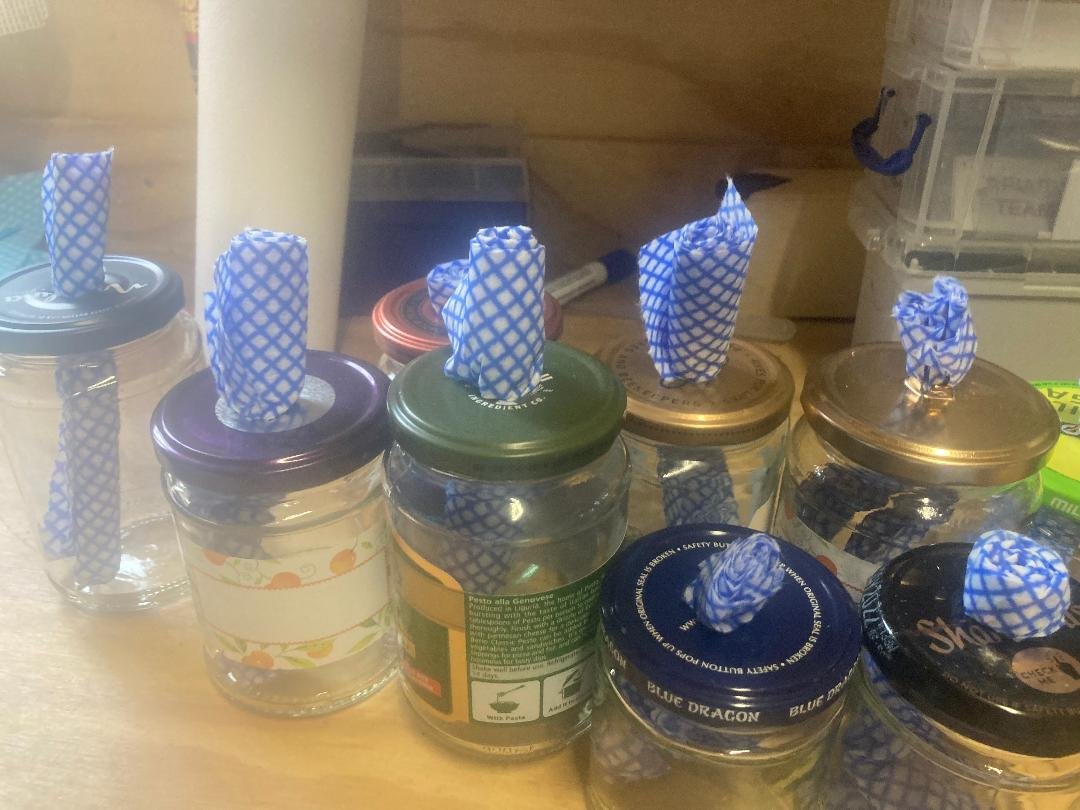Jam jar pot lures. An attractant is put in the jar which wicks up the cloth. The lure must be checked frequently for signs of activity.
Asian hornets
This is a big subject, and I cannot do it justice. Once established in the UK, these hornets will have a massive effect on beekeeping practices and nature. To raise their brood they eat a protean rich diet: Pollen, tree resin, and nectar. When they need protein, they prey on insects that visit flowers. Honey bees are an abundant source of protein, so they are a prey of choice. When they become established in the UK, I anticipate that many beekeepers will quit. Here are a few thoughts:
Predation starts in July and builds up through August until it reduces in late September / October but may persist through November. It is best to keep a minimum of five hives per apiary. Keeping fewer hives will be unsustainable.
Manipulations must be done early in the day.
Complete queen rearing and mating before the end of June.
Varroa treatments involving vapour like MAQS are best avoided in the autumn. They stress bees.
Trapping should be delayed until the first hornets appear. Otherwise, the bait may attract more hornets. The attraction may make trapping counterproductive. There are several designs. The Jabeprode trap has a conical entrance mounted on a baited box.
Jam jar-type traps should be avoided due to bycatch.
Avoid opening hives through the hornet predation period. If essential, it should be performed early or late in the day.
Small colonies are at greatest risk. So Nucs must be strong by July and may need to be united. Vertical splits will make sense to re-queen.
A mega problem is that bees can die of stress and starvation. They may kill their queen and abscond. If five to 12 hornets are flying outside their hive, the bees stop foraging, which is called foraging paralysis.
Asian hornet Overview 2022
Management of Asian hornets in the apiary and reducing bee stress BBKA presentation
Their stings are more likely to cause Anaphylaxis than with honey bees (still rare).
Numerous hornets will attack if someone ventures within five metres of their nest. This is not always the case. I heard of some young people having a party in a barn in France with a nest on the beam above them. Away from their nest, they are not aggressive.
Their stingers are 6 mm long, so a standard bee suit does not afford protection.
In the autumn, the hive entrance must be reduced to 5.5 mm to foil mass attacks
Electric harps (circa one metre high) are vertical steel wires charged to a high voltage. Bees fly through them, but Asian hornets are frightened or electrocuted (stunned). Harps should be placed perpendicular to the entrances and are most effective if they are sited close to the entrances, between a pair of hives. Using one harp per three colonies is less beneficial but more feasible. The hive entrances should be 20-30 cm apart.
A cage (muzzle) mounted in front of the hive with a mesh size of 1–2.5 cm protects the bees (somewhat) as they fly in and out. A variant is “Stop it”.
Seal the space under the hive so that hornets cannot hide and ambush bees.
Leave the Varroa board in to reduce the bees' stress. Doing this and reducing the entrance could lead to bees overheating, particularly in wooden hives that are not positioned in the shade.
